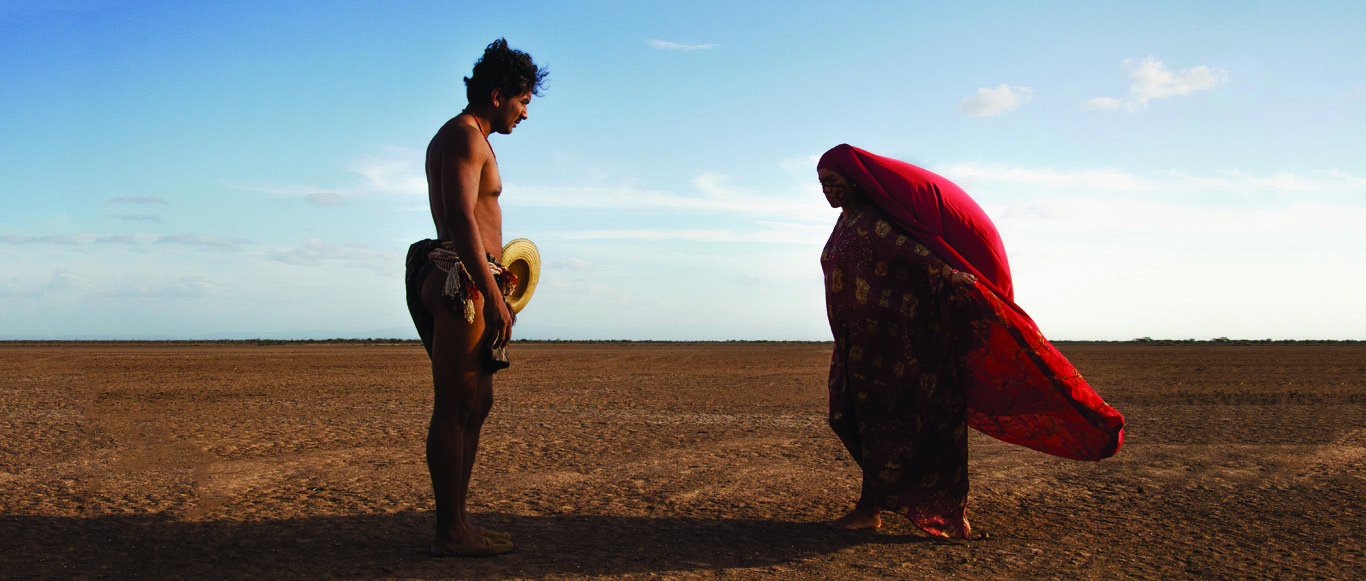
Review: Birds of Passage
By Olek Młyński
The team behind Embrace of the Serpent has returned with a new work which employs western and gangster film genres in a subversive and clever way. These two iconically Hollywood genres allow the directors Cristina Gallego and Ciro Guerra to rework Colombian history and tell a story from a perspective which is, until recently, rarely encountered in cinema.
In Birds of Passage the directors are casting a revisionist look toward the impact of the global drug trade on small tribal communities of the Guajira region in Colombia. The film is divided into five songs, each set in a different period. At the heart of them stands the protagonist, Rapayet. To earn dowry to marry Zaida he becomes a gangster. This triggers a shift in crime, violence and hatred between the conservative tribes. To quote Robert Warshow’s famous essay Gangster as the Tragic Hero, “brutality is the content of [gangster’s] success”.
Several temporal jumps visually emphasise how the sets of values the characters had been following for centuries quickly become irrelevant within two decades. Tribes turn into cartels, goats are exchanged into automatic rifles, and any sense of connection with the land becomes broken as soon as the US dollars start to flow into the local economies.
In the opening sequence we see a shepherd wearing indigenous clothing and sunglasses. It’s one of the many jarring moments in the film where the local culture is juxtaposed with the artefacts of Western origin. Like in a fable, the film begins with the character singing about the toil of his people. In the final sequence his tale concludes with the daunting: “Strong winds come to erase our footprints” in one of the many moments when the realist film becomes intruded by a more lyrical tone.
The Americans, the true source of all this money and moral decay, are barely present on the screen. Every time we actually see them, there is a feeling of ridiculousness surrounding them. “They say they rally against communism, but really they are desperately trying to find marijuana” is what we hear from Moises, Rapayet’s friend early into the film.
In the film there were two scenes that seemed to be ironic visual nods to Herzog’s Aguirre, Wrath of God and Fitzcarraldo. The directors recreate the opening sequence of Aguirre, yet in their film it is not the conquistadors that we see, but a caravan of donkeys smuggling weed. In another scene the viewer sees men burying planes in the sands of the desert – a reference to Fitzcarraldo who thought it was possible to pull a massive boat through the Amazon forrest. These jokes perhaps signify how the cinematic representation of South America has always been a site for European or American directors’ imagination. Yet, Birds of Passage give voice to those who were always ‘othered’ as mere objects of the gaze.
Each song represents a temporal leap. It is suggestively emphasised by the characters’ costumes. They subtly move from traditional garments through an awkward mix of the former with the western clothing, to end with the tribesmen dressed up like characters straight from Miami Vice. This transition is so shockingly quick due to clever usage of props and costumes. In one of the most humorous scenes in the film we see a 10-year old Leonidas casually drive a massive Land Rover.
The film successfully operates on two levels. First one is that of a brutally realist gangster film that easily could have been a part of Scorsese’s oeuvre. The other is that of a much more contemplative, eerie and aesthetically oneiric fable. Birds of Passage can be again linked to Robert Warshow’s essay in which he wrote that “the typical gangster film presents a steady upward progress followed by a very precipitate fall”. Yet in the Colombian film the viewer witnesses the fall from the opening minutes. It is not a fall of a single character, but of an entire community and values it always respected.
The film creates a sense of disjointment between the Colombian tribes and the environment they inhabit. In one of the scenes most overtly representing this disconnect Miguel, son of Zaida and Rapayet, says: “I want to learn how to fly a plane, not how to ride a horse”. This is further emphasised by the stunning cinematography. Static, wide-angle shots with natural lighting are employed in order to capture the beauty and danger of Guajira region. The way the takes were composed often reminded me of Hieronymus Bosch’s paintings were the painter managed to incorporate a stunning amount of, often horrifying, details onto the canvas. Birds of Passage capture a similar feeling of natural beauty spoiled by humans.
Olek Młyński is a 3rd year Film Studies and English Literature student at University of Sussex, he is the online film editor at The Badger, where you can see more CINECITY reviews by Sussex students, and vice-President of Sussex Film Appreciation Society.
